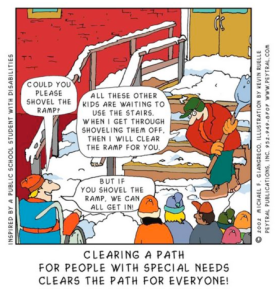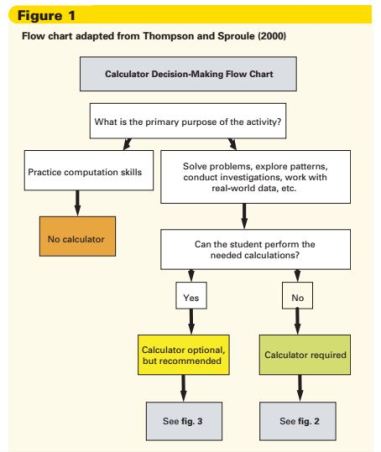When it comes to planning lessons in special education, or general education for that matter, the goal is for all students to be able to access, understand, and be able to successfully apply the content to show evidence of full understanding. The application can take many forms: performance assessments, formative assessments, summative assessments, teacher observations, etc…
But how do you get to that final assessment piece? This post is about the planning process that goes into successful lessons for all students. Let’s begin with Universal Design for Learning (UDL). UDL is a model for planning lessons and units that creates access to the content for all students. Here is a cartoon that embodies the philosophy of UDL.
One major component of planning in special education math classes is prioritizing the mathematical goals and the needs of the students to access the mathematics in a lesson. A Teaching Children Mathematics article from 2004 suggests the following steps for beginning to plan a successful math lesson for students with disabilities:
1. Focus on the mathematics
- What are the mathematical goals?
- What is most important for all students to learn?
2. Focus on the students
- What are each student’s strengths?
- What are each student’s weaknesses?
3. Identify barriers
- What is the match or mismatch of the lesson with the student’s strengths and weaknesses?
4. Brainstorm accessibility strategies
- What scaffolding and support will students need to reach the mathematical goals?
The article says you need to first start with the math, then the students, then the barriers, finally the accommodations. One controversial accommodation is the use of calculators. This has become especially topical because of the advent of this handy dandy app.
But the use of calculators has long been a major component of special education math classes. DeAnna Horstmeier, Ph.D. says in her book, “Teaching Math to People with Down Syndrome and Other Hands-On Learners” (2004)
Students with Down syndrome frequently have difficulties with short-term and working memory, especially if the occasion is not very meaningful to them. For example, have you ever known a child with Down syndrome to forget his Christmas list or forget when you said you would take him to the zoo? Those kinds of things they remember too well. On the other hand, they often have trouble holding abstract numbers in mind and have even more difficulty with using working memory to tell them what they need to do with those numbers, such as add or subtract (p. 52).
Horstmeier also quotes the National Council of Teachers of Mathematics about the importance of technology in math class, “Appropriate calculators should be available to all students at all times.” Availability and advocating for the use of are two VERY different things. Should students with disabilities, such as Down syndrome, be handed calculators as soon as math class begins? Or should the students be given the option of using calculators depending on their needs during a mathematical task?
Horstmeier was quoting the 1989 NCTM Curriculum and Evaluation Standards. NCTM weighed in again in a 2005 article entitled Calculators for Students with Special Needs.
In general, even with the calculator, students with disabilities face difficulties in learning many mathematical ideas. In a rich mathematics problem, however, the calculator shifts the focus of attention from computation, which the calculator can do, to thinking, which the calculator cannot do, and may help students with disabilities attain levels of understanding that are equal to those of their fellow students. In these situations, a calculator serves as a tool rather than a crutch because it requires the students to think through and solve the mathematics problems. Even with a calculator, students need to learn to make sense of the answers attained with the calculator, which procedures and operations are required in a problem, and how to generalize results to other situations.
Horstmeier advocates that a calculator will assist the student’s working memory while working on a mathematical problem, but NCTM maintains that a calculator can only help a student so far, disability or not. The article contains this handy flow chart for determining the use of a calculator during a lesson.
In essence, if all you are asking a student to do is practice computation then don’t let them use a calculator. If the task is a richer, deeper mathematical task then a calculator can only help a student so far. It is also my opinion that if your math task or problem can be completed solely by a calculator, then you may want to re-evaluate your mathematical task or problem and its use to the mathematical development of your students.


